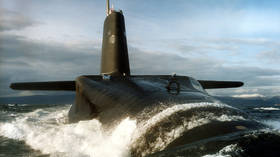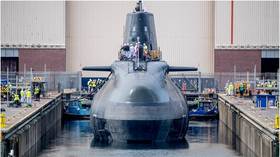UK nuclear submarine barely avoids disaster – The Sun

Britain came close to losing one of its four Vanguard-class nuclear submarines, as key equipment malfunctioned aboard the decades-old vessel, The Sun reported on Sunday.
A disaster almost happened when the sub, armed with Trident II nuclear missiles, was preparing to start a patrol mission in the Atlantic, the tabloid said, without revealing the date of the incident.
According to a source who talked to The Sun, the depth indicator aboard the Royal Navy vessel had broken down. This led the commanders to believe that the submarine had stopped its descent, while it actually kept going deeper.
The vessel with 140 crew members aboard reportedly came close to reaching the “danger zone,” where it would have been crushed by the water pressure if not for the engineers who spotted the problem via a second gauge in the back of the sub, the report said.
“It’s not the engineers’ job to control the sub’s depth but they saw how deep they were and realized something was wrong,” according to the source, who added that the problem was identified “at a depth where we know it [the submarine] can operate,” though if “it had carried on going, it doesn’t really bear thinking about.”
The Sun noted that it could not name the submarine or the unsafe depth at which it descended due to security reasons.
According to the tabloid, if the sub had kept descending, “such a catastrophe would also have triggered a nightmare salvage mission to recover the top-secret vessel and its nuclear reactor before the Russians got to the scene.”
A Royal Navy spokesperson told The Telegraph that, “while we do not comment on specific details regarding submarine operations, safety of our personnel is always the highest priority.”
“Our submarines continue to meet their commitments, deploying globally on operations, protecting national interests, and keeping us and our allies safe,” the spokesperson added.
Four Vanguard-class nuclear submarines – Vanguard, Victorious, Vigilant and Vengeance – were built by the UK from 1986 to 1999. But only two of them are operational at the moment, with one other currently being upgraded and another undergoing sea trials after repairs.
In February, The Sun reported that the Royal Navy ordered an investigation after its inspectors found that broken bolts in the reactor chamber of HMS Vanguard were fixed with superglue during maintenance.
Britain’s largest military vessel, the HMS Prince of Wales, has also been plagued by various technical problems. The Times reported late last year that the £3.2 billion ($3.8 billion) aircraft carrier had spent more time docked for repairs than on duty since being commissioned in 2019.












